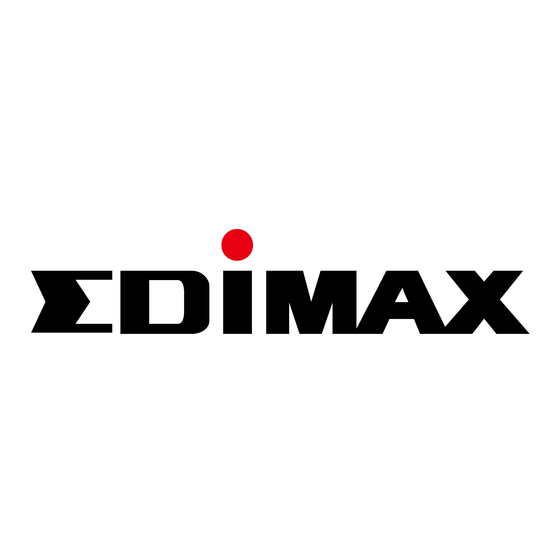
Summary of Contents for Edimax EW-7317LD
- Page 1 User’s Manual Version: 1.0 (Dec 2005)
- Page 2 COPYRIGHT Copyright © 2004/2005 by this company. All rights reserved. No part of this publication may be reproduced, transmitted, transcribed, stored in a retrieval system, or translated into any language or computer language, in any form or by any means, electronic, mechanical, magnetic, optical, chemical, manual or otherwise, without the prior written permission of this company This company makes no representations or warranties, either expressed or implied, with respect to the contents hereof and specifically disclaims any...
- Page 3 Federal Communication Commission Interference Statement This equipment has been tested and found to comply with the limits for a Class B digital device, pursuant to Part 15 of FCC Rules. These limits are designed to provide reasonable protection against harmful interference in a residential installation.
- Page 4 The R&TTE Directive repeals and replaces in the directive 98/13/EEC (Telecommunications Terminal Equipment and Satellite Earth Station Equipment) As of April 8, 2000. Safety This equipment is designed with the utmost care for the safety of those who install and use it. However, special attention must be paid to the dangers of electric shock and static electricity when working with electrical equipment.
-
Page 5: Table Of Contents
CONTENTS 1 INTRODUCTION ................1 ....................1 EATURES .................... 1 PECIFICATIONS ..................1 ACKAGE ONTENTS 2 THE OUTWARD APPEARANCE OF THE WI-FI DETECTOR ... 2 3 HOW TO CHARGE THE WI-FI DETECTOR........ 3 4 HOW TO USE THE WI-FI DETECTOR......... 4 5 APPENDIX .................. -
Page 6: Introduction
1 Introduction Thank you for purchasing this 802.11b/g Wi-Fi Detector. This convenient device instantly detects wireless hotspots anywhere. The backlightt LCM display tells the user detailed information about any detected hotspot. There’s no need to purchase any battery because there is a rechargeable Li-Polymer battery which recharges whenever the detector is inserted into any USB port. -
Page 7: The Outward Appearance Of The Wi-Fi Detector
2 The Outward Appearance of the Wi-Fi Detector... -
Page 8: How To Charge The Wi-Fi Detector
3 How to charge the Wi-Fi Detector 1. Remove the cap from the Wi-Fi Detector and carefully insert the USB connector into any available USB port on your computer. You will see the recharging screen. The battery strength indicator will be animated while the Wi-Fi detector is being recharged. 2. -
Page 9: How To Use The Wi-Fi Detector
4 How to use the Wi-Fi Detector 1. Slide the power switch to the “ON” position, and a welcome screen will greet the user. 2. After the welcome screen is displayed the Wi-Fi detector will automatically enter scanning mode to detect Wi-Fi signals. In scanning mode the display will display the total number of both non-encrypted and encrypted Wi-Fi signals detected. - Page 10 The Icons on the LCM display are displayed as follows: 1. INFRA indicates the signal is an infrastructure mode signal, ADHOC indicates the signal is an Adhoc mode signal. 2. “g” indicates the signal is a 802.11g wireless signal. “b” indicates the signal is a 802.11b wireless signal.
-
Page 11: Appendix
5 Appendix This chapter provides some information about IEEE 802.11b/g standards. 1. What is the IEEE 802.11g standard? 802.11g is the new IEEE standard for high-speed wireless LAN communications that provides for up to 54 Mbps data rate in the 2.4 GHz band. 802.11g is quickly becoming the next mainstream wireless LAN technology for the home, office and public networks. - Page 12 5. What is Infrastructure? An integrated wireless and wireless and wired LAN is called an Infrastructure configuration. Infrastructure is applicable to enterprise scale for wireless access to central database, or wireless application for mobile workers. 6. What is BSS ID? A specific Ad hoc LAN is called a Basic Service Set (BSS).
- Page 13 12. What is DSSS?What is FHSS?And what are their differences? Frequency-hopping spread-spectrum (FHSS) uses a narrowband carrier that changes frequency in a pattern that is known to both transmitter and receiver. Properly synchronized, the net effect is to maintain a single logical channel. To an unintended receiver, FHSS appears to be short-duration impulse noise.



